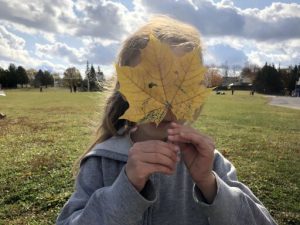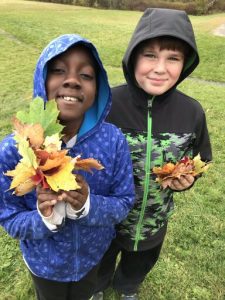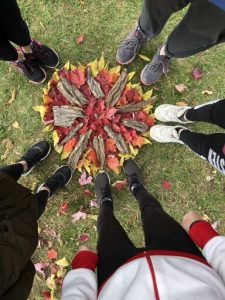Reimagining School: What If We Physically Distanced From Four Walls and A Desk?
 We know the future of school is likely to look a whole lot different when it reopens. As the current school year comes to a close, provincial education departments, educators, and parents are grappling with what September will bring in terms of educating children and youth across the country. Naturally there will be variations and nuances across Canada, but there is one aspect of the future of school that could and should look the same throughout: more time outside.
We know the future of school is likely to look a whole lot different when it reopens. As the current school year comes to a close, provincial education departments, educators, and parents are grappling with what September will bring in terms of educating children and youth across the country. Naturally there will be variations and nuances across Canada, but there is one aspect of the future of school that could and should look the same throughout: more time outside.
Outdoor learning as a central feature of a student’s education at all levels could have a resounding positive impact on health and wellness. Learning outside could address both the immediate concerns posed by Covid-19 as well as many of the other health, wellness and environmental crises of our time, including some which have been amplified by the Coronavirus. Whether it’s mental health, obesity, loneliness, the climate emergency, or biodiversity collapse, these are crises that need immediate attention if we are to offer our children and youth a liveable future.
 Consider this: school days centered in the outdoors, focused on place-based learning could lead to happier, healthier, more resilient students who are ready to learn and who are inspired intrinsically to look after the planet(1), and are offered the tools to do so. Outdoor learning also offers an equality angle – outdoor spaces in our communities are not necessarily accessible to all which means some young people can reap the benefits of outdoor time in nature while others cannot. Offering significant regular and frequent outdoor time at school can help address that inequity.
Consider this: school days centered in the outdoors, focused on place-based learning could lead to happier, healthier, more resilient students who are ready to learn and who are inspired intrinsically to look after the planet(1), and are offered the tools to do so. Outdoor learning also offers an equality angle – outdoor spaces in our communities are not necessarily accessible to all which means some young people can reap the benefits of outdoor time in nature while others cannot. Offering significant regular and frequent outdoor time at school can help address that inequity.
The body of scientific evidence is compelling. Regular time being, playing and learning outdoors in and near nature is essential for healthy childhood development (social, emotional and physical), decreases the risk of infectious disease spread and builds resiliency (i.e. the ability to adapt to stressful and life-changing situations)(2). It has also been shown to lead to greater focus, higher cognitive function and better learning outcomes, across the board(3). And student-led activities (i.e. unstructured play) allows children and young people to learn essential life skills on their own terms, enhancing creative-thinking and problem-solving(4). Regular outdoor time also:
- increases physical activity and builds confidence in being outdoors, leading to a more active lifestyle in later years;
- connects us to the places we live and the environments we need to protect;
- boosts mental health;
- lowers stress and boosts immunity(5)
The benefits of being outdoors, playing and learning last beyond early childhood and are important for all ages, including teachers. In short, being outdoors creates healthier kids – and adults too!
 Rarely are we confronted with a crisis so big that rattles our institutions to the core and offers an opportunity to rethink and redesign the systems we have taken for granted. As we grapple with the need to keep our children safe from infection of Covid-19 and prevent a resurgence in the spread of the Coronavirus in our country, we have a rare opportunity to reimagine how school is structured and organized. We can implement new ways of being and doing, teaching and learning that better serve our children, our communities and the wider world so that we not only reduce the spread of coronavirus but also address the pre-existing health, wellness, inequality and environmental crises of our time.
Rarely are we confronted with a crisis so big that rattles our institutions to the core and offers an opportunity to rethink and redesign the systems we have taken for granted. As we grapple with the need to keep our children safe from infection of Covid-19 and prevent a resurgence in the spread of the Coronavirus in our country, we have a rare opportunity to reimagine how school is structured and organized. We can implement new ways of being and doing, teaching and learning that better serve our children, our communities and the wider world so that we not only reduce the spread of coronavirus but also address the pre-existing health, wellness, inequality and environmental crises of our time.
Fortunately, Indigenous people who have lived on this land for thousands of years have provided this country with a growing awareness of the need to get people outside for nature connection, physical activity and environmental awareness. There is a wealth of expertise, experience and knowledge that can be accessed and applied to the remodelling of school. In fact, there are schools and school districts in parts of Canada where outdoor learning is already a significant part of the school routine, providing an opportunity to see how it’s done on the ground. In addition, there are many groups and organizations provincially, nationally, as well as internationally focused on enabling, supporting and facilitating more outdoor time among children and youth at school and beyond. Many have created and offer tools and resources (often for free) for teachers (and parents) including curriculum-based activities for pretty much every grade and subject matter. In fact, you’ll find that there are not many things that can’t be taught outside – it just takes creativity. We have begun to assemble a list of resources below and we’ll continue to build on this.
The Covid-19 crisis has forced us to react and change overnight, allowing us to see just how adaptable we all can be, including some of our biggest systems. So now, as we look forward, with a little time to reflect and plan through the summer, we have a rare opportunity for doing things differently into the future, both to protect against a resurgence of the virus and to address the other crises that will, left unchecked, compromise that healthy future we want our children to grow into.
Our education system is pivotal to helping us steer a new course. So, as we think about and plan for a new normal in schools in the fall to address the immediate need for physical distancing, we can implement changes that will address so many other needs too.
References
[1] Wells, N.M., & Lekies, K. S. (2006, January). Nature and the Life Course: Pathways from Childhood Nature Experiences to Adult Environmentalism. Children, Youth and Environments, 16(1).
[2] American Psychological Association, 2020
[3] Children and Nature Network, 2018. Connecting with Nature to Care for Ourselves and the Earth. Recommendations for Decision Makers
[4] Tremblay, M. S., Gray, C., Babcock, S., Barnes, J., Bradstreet, C. C., Carr, D. Brussoni, M. (2015). Position Statement on Active Outdoor Play. International Journal of Environmental Research and Public Health, 12, 6475-6505.
[5] Children and Nature Network, 2018. Connecting with Nature to Care for Ourselves and the Earth. Recommendations for Decision Makers






Bruce
July 4, 2020 (8:31 am)
Great idea. The only problem is….Weather across the US during the school year will prevent timing and length of staying outside. Planning for inside and outside will have to be thought-out. All ideas on the table.
Louise Ormerod
July 6, 2020 (10:45 am)
We are building an outdoor classroom so looking for ideas and support to convince community of its importance.
Thank you
Curtis Goodman
July 7, 2020 (4:06 pm)
Great perspective! Thank you for encouraging us to make the most of a difficult situation!!
Candace Pew
July 10, 2020 (5:06 am)
Let me know if you need future funds. My grand babies attend your beautiful school and I’d like to participate.
KarenGiuffre
July 10, 2020 (8:18 pm)
We @Voyagersnj will be returning to school, if allowed, for six hours each day. Every classroom will spend a minimum of two hours outdoors, where they will engage in learning across curriculum, while breathing fresh air, observing nature, and workIng beside their classmates to become environmental ambassadors. That’s what we do!
dana
July 16, 2020 (10:11 pm)
brilliant!
This Is The Case For Outdoor-Centered Classrooms – BetterBabyDeals.com
July 20, 2020 (11:38 am)
[…] This post first appeared on Take Me Outside […]
This Is The Case For Outdoor-Centered Classrooms ⋆
July 20, 2020 (5:41 pm)
[…] This post first appeared on Take Me Outside […]
This Is The Case For Outdoor-Centered Classrooms – My WordPress
July 21, 2020 (4:08 am)
[…] This post first appeared on Take Me Outside […]
L. Williams
August 24, 2020 (7:43 pm)
Absolutely fantastic! I taught internationally for years and all of this is 100% SPOT ON. The children I taught in Norway had two 45 minutes recess periods a day in rain, snow, sleet and wind. The only cancelled in cases where the air temperature dipped dangerously low.
I was in awe when I started teaching there and realized they had an hour and half of recess A DAY but I quickly understood why their population stays so healthy and active – THEY SPEND TIME OUTDOORS!!! And a lot of it!! For everyone’s sake I hope this time makes us better and stronger. Hang in there.